Boas are unquestionably commonplace snakes amongst those who like legless pets, and that’s due largely to their selection. A gaggle comprised of 30-odd species (counting on the authority you search the recommendation of), boas (the subfamily Boinae) have one factor to provide everyone.
We’ll dive into just some of basically essentially the most typically saved boa species below, to have the ability to select the pet that’ll most interesting suit your circumstances and desires.
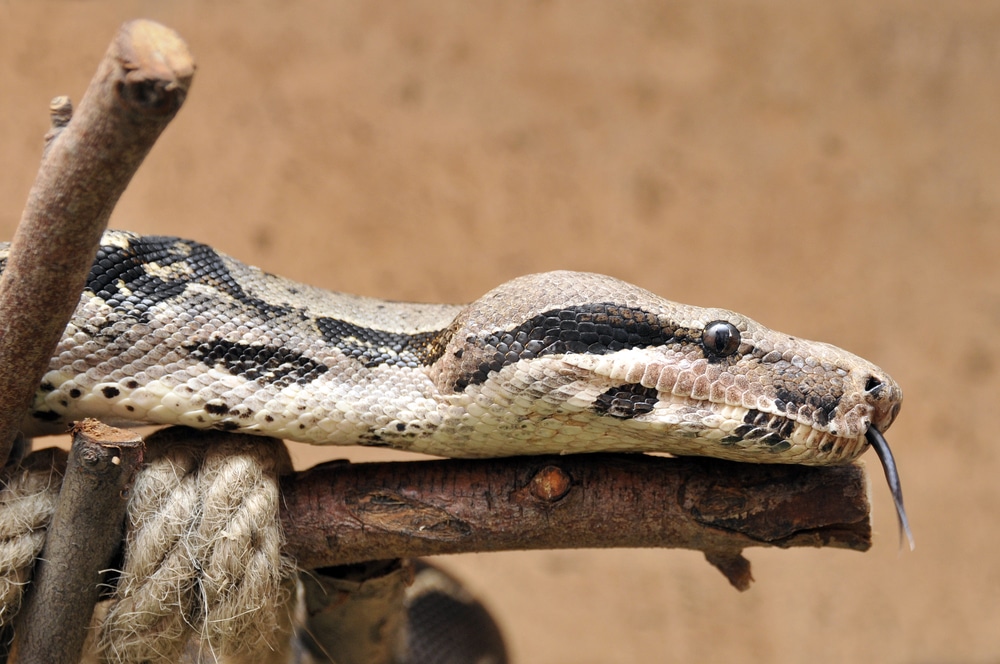
So let’s get into the basics biology of each, along with the basic care and maintenance requirements – along with the issue each presents their keeper.
Quick Disclaimer: We’re Using “Species” Broadly
We have to familiarize our readers with the sorts of boas that are typically accessible throughout the pet commerce.
Accordingly, we’re not getting slowed down in taxonomic factors surrounding how some species are outlined. A variety of the animals below are actually fully totally different subspecies or geographic variants, moderately than fully totally different species.
Merely know that we indicate “varieties of boas principally saved as pets.”
The Seven Boa Constrictor Species Most Typically Saved as Pets
There aren’t any official statistics regarding which boa species and subspecies are principally saved by reptile followers, nevertheless we think about the following seven usually tend to be essentially the most well-liked.
1. Frequent Boa
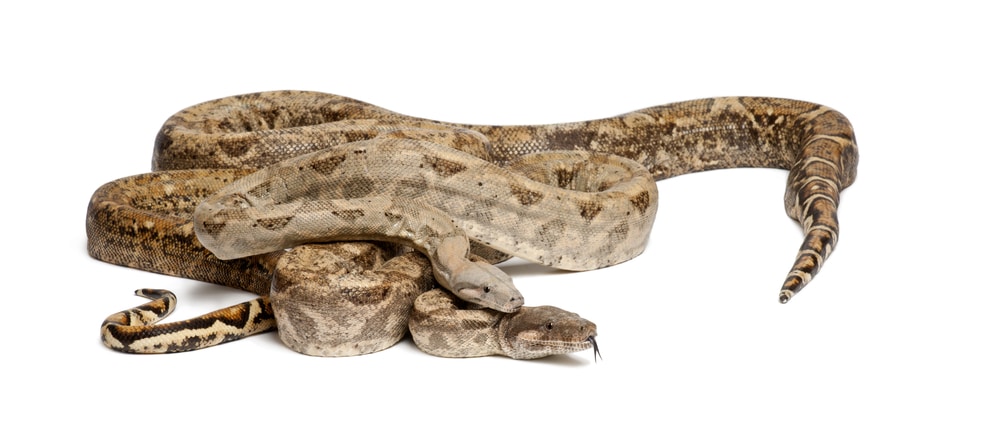
Whereas just some points about boa species fame may be exhausting to pin down with certainty, one issue is apparent: The frequent boa (Boa constrictor imperator) is basically essentially the most typically saved boa amongst reptile followers.
Frequent boas differ from Mexico to central South America, they often inhabit numerous fully totally different habitats all through this differ. Most keep in forests of 1 choice or one different, nevertheless some are current in residential areas, open swamps, lake margins, or wide-open fields and savannas. Though they’re all of the an identical subspecies, they differ comparatively significantly by means of coloration, pattern and measurement all through this big differ. Really, some that are found dwelling on islands – such as a result of the Hog Island boa – are colored pretty another way than typical members of the group.
Boas have been frequent amongst snake-keeping followers for a few years. That’s due partially to their shut proximity to the USA – African and Indonesian constrictors are merely found farther away and had been subsequently tougher to amass beforehand. Nonetheless, even in our modern, interconnected world, frequent boas keep a lot of the most well liked constrictors throughout the pet commerce. Nonetheless, almost all of frequent boas saved in captivity proper now are born and bred in captivity.
One other excuse for the popularity of frequent boas is their often-docile nature. This varies vastly from one animal to the following, as some are pretty defensive and ready to chunk if threatened. Nonetheless, captive bred specimens usually keep as a lot as their reputation for being tame, considerably in the event that they’re raised from a youthful age and handled gently and persistently over time.
Boas most likely widespread about 6 or 7 toes in dimension. Nonetheless this varies, and these snakes moreover exhibit sexual dimorphism – females attain rather a lot larger sizes than males. Some males will not ever exceed 4 toes in dimension, nevertheless female specimens may generally measure 9 toes in dimension or further and weigh as a lot as 50. Like all totally different boas, frequent boas are livebearers, who usually produce huge litters after extended gestation durations.
Frequent boas are comparatively easy to care for, and captive-bred folks usually eat readily. Nonetheless, given their huge measurement, we’d hesitate to characterize them as “beginner” snakes.
2. Purple-Tailed Boa
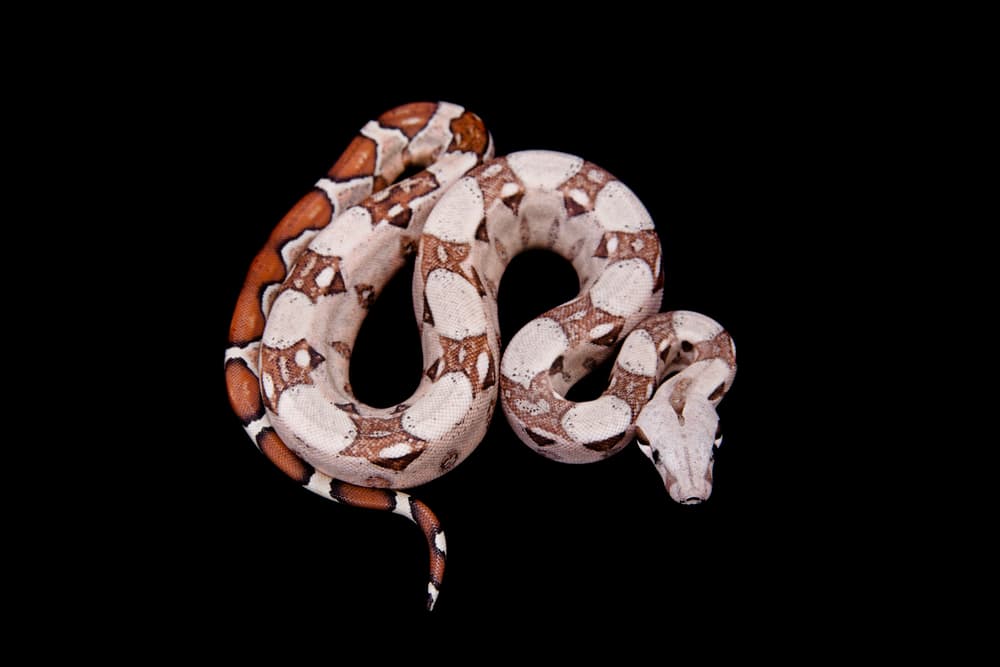
The time interval red-tailed boa is often mistakenly utilized to frequent boas, nevertheless true red-tailed boas are actually a particular subspecies: Boa constrictor constrictor.
Purple-tailed boas are pretty identical to frequent boas in some methods, nevertheless many reptile followers strongly favor the earlier to the latter. Purple-tailed boas are prone to possess sharper markings and brighter coloration (considerably throughout the tail), and some develop larger than frequent boas too.
Purple-tailed boas aren’t pretty as frequent in captivity as frequent boas, nevertheless they’re out there for hobbyists trying to find them out. True red-tailed boas often value a bit larger than their frequent cousins, nevertheless this varies a bit based totally on the position from which the red-tailed boa hails (they differ pretty a bit all through their differ).
Purple-tailed boas are bred in captivity with some regularity, nevertheless an enormous proportion of those throughout the pet commerce are nonetheless wild-caught, imported animals. This, combined with the reality that red-tailed boas are a bit harder to care for and often further nervous than frequent boas, makes them larger fitted to keepers with slightly bit of experience. Furthermore, whereas many individuals are pretty tame, red-tailed boas are usually not as docile as frequent boas.
3. Rosy Boa
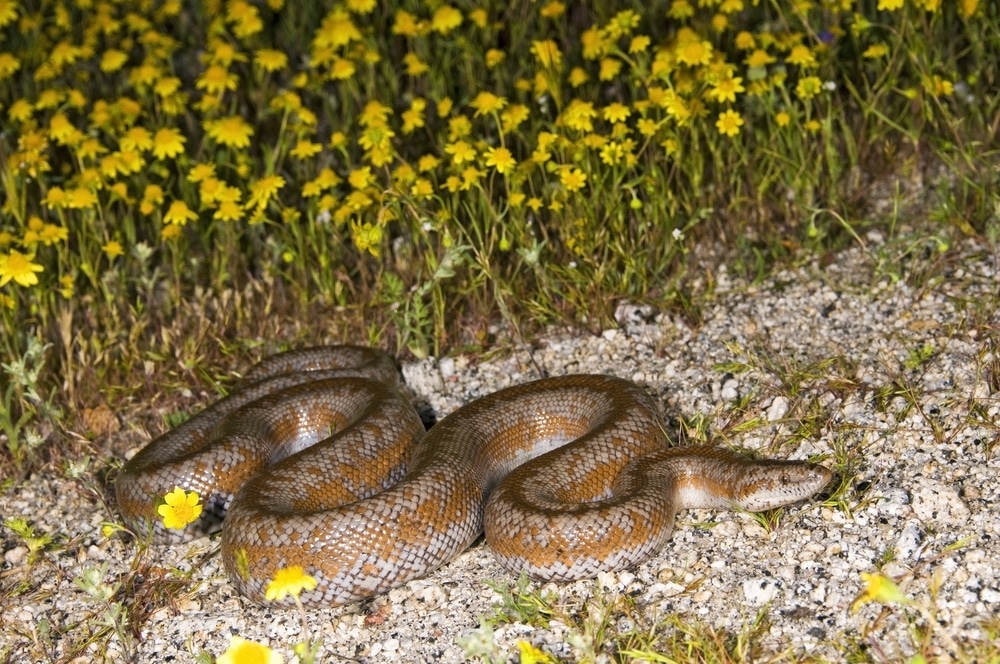
Not like frequent and red-tailed boas, rosy boas (Charina trivirgata) are pretty small – most measure decrease than 3 toes in dimension. Moreover not like their larger cousins, rosy boas bear very fully totally different coloration patterns: Whereas frequent and red-tailed boas are largely brown or grey with perpendicularly oriented markings, rosy boas occur in a lot of fully totally different colors (along with orange or peach), they often possess longitudinal stripes – a unusual trait amongst boas and totally different huge constrictors.
Although temperaments vary from specific particular person to specific particular person, most rosy boas are pretty docile animals, who’re disinclined to chunk. When you combine these gentle tendencies with the species’ small measurement, rosy boas end up being pretty good pets for beginning snake keepers.
Rosy boas are moreover comparatively easy to keep up. Most can be housed in just some sq. toes of home, they often have pretty easy-to-satisfy needs in captivity. This not solely makes them pretty easy to take care of, nonetheless it moreover implies that keepers can prepare comparatively elaborate, well-decorated enclosures within the occasion that they like.
Rosy boas, not like frequent and red-tailed boas, hail from the American southwest. Which signifies that they often thrive most interesting in comparatively low-humidity habitats, not like their tropical and sub-tropical cousins, who require their keepers to care for extreme humidity ranges. It moreover means points like respiratory infections and poor sheds are a lot much less frequent in rosy boas.
Rosy boas are bred in huge numbers, so keepers might don’t have any trouble discovering captive-bred specimens. Most are comparatively cheap too. These parts all combine to make them an excellent boa for novices – arguably, the proper chance of the group.
4. Kenyan Sand Boa
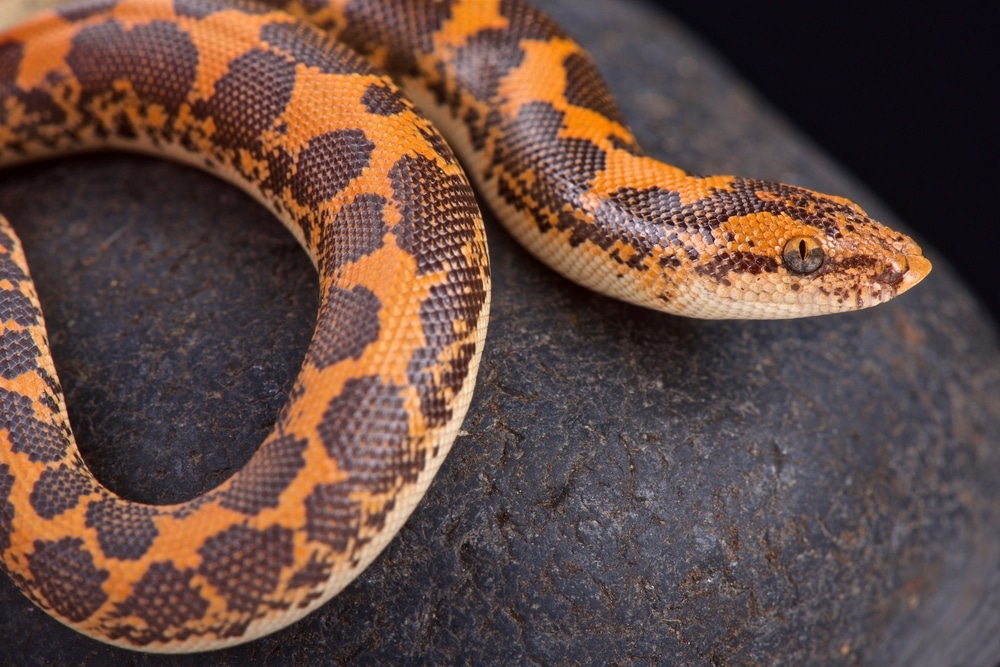
If the rosy boa is the proper boa for novices to keep up, the Kenyan sand boa (Gongylophis colubrinus) is certainly the runner up (and some would argue we should all the time swap these species). Actually, the Kenyan sand boa is an efficient chance for boa-keeping novices. As a species, it is often pretty tame, remarkably hardy, and actually undemanding. Give a Kenyan sand boa a warmth, sandy, and secure enclosure, and he’ll thrive.
The primary motive we cost the Kenyan sand boa barely behind the rosy boa by means of beginner suitability is a bit unusual. If we’re going to be reliable, sand boas could possibly be a bit boring to keep up. They spend nearly all of their time buried beneath the substrate, they often don’t even switch spherical very rather a lot when handled (though they’re often pretty docile). This will set off some fledgling keepers to lose curiosity, thereby inflicting them to neglect their pet. However when their life-style and attribute character aren’t an issue, then they’re a really perfect various for novices.
There are a selection of sand boa species and subspecies, and all inhabit some portion of a range stretching from central Africa to central Asia. Nonetheless, the Kenyan sand boa is the most common, out there, and easy-to-keep species accessible.
The largest Kenyan sand boa females seemingly attain or exceed 3 toes in dimension, nevertheless the overwhelming majority are smaller. Males, notably, not usually exceed 2 toes or so. Captive bred sand boa neonates are very low-cost, though there are some coloration mutations accessible, which fetch elevated prices.
5. Amazon Tree Boa
Amazon tree boas (Corallus hortulana) are fairly widespread, arboreal boas from Central America. They occur in a lot of fully totally different coloration varieties, along with just some that are pretty participating, they often have a extremely distinctive physique type. They’re very prolonged, pretty slender, they often possess giant, cumbersome heads.
Amazon tree boas are generally considered the “poor man’s emerald tree boa,” nevertheless that does a disservice to these animals, who differ in some methods from their inexperienced cousins. As an illustration, whereas emerald tree boas usually laze about for hours in a attribute draped-over-a-branch coil, Amazon tree boas are further energetic and usually favor resting throughout the crooks of tree branches. For that matter, these snakes will readily descend to the underside at events – a trait that all the time frustrates keepers who want a frequently arboreal animal.
Amazon tree boas usually make rewarding pets, they often’re actually a bit underappreciated in our opinion. For that matter, they’re pretty cheap (notably participating specimens aside), they often’re not usually troublesome to hunt out throughout the pet commerce. Wild-caught folks positively outnumber captive-bred specimens, nevertheless you will discover every varieties with ease.
Nonetheless, they don’t seem to be a really perfect various for novices. These snakes are generally very defensive, bordering on pugnacious, which many novices will uncover off-putting. Some folks could be troublesome to feed. And whereas amazon tree boas aren’t troublesome for educated keepers to care for, they will seemingly be pretty troublesome for a lot of novices.
6. Emerald Tree Boa
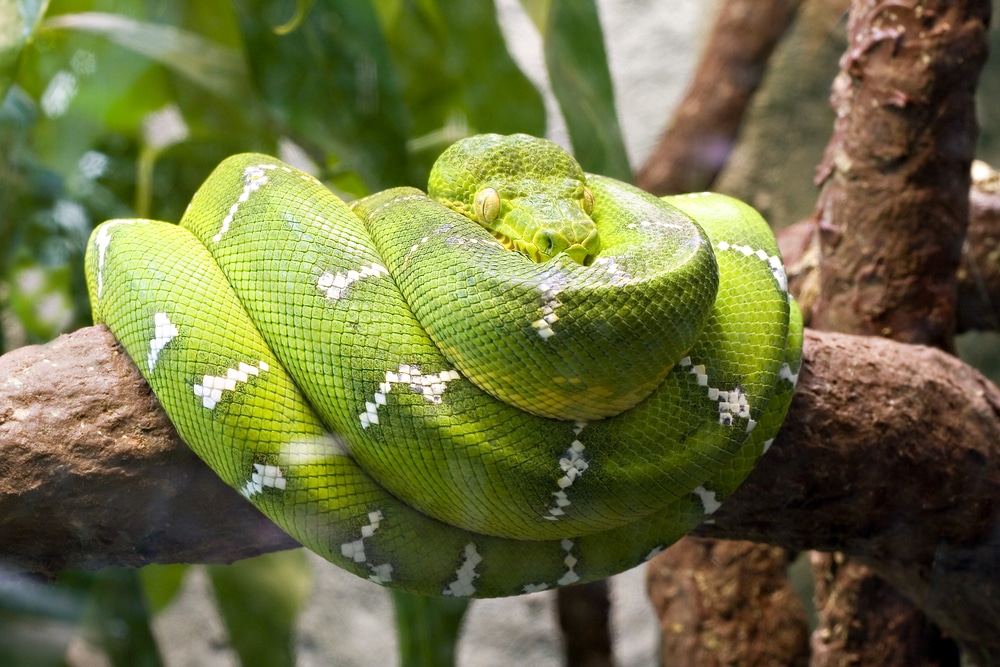
Most likely essentially the most well-known boas on this planet, the emerald tree boa is straight away recognizable – as long as you can distinguish the species from the similar-but-very-distantly-related inexperienced tree python (Morelia viridis). These two very distant cousins exhibit a phenomenon known as convergent evolution, which suggests that their evolutionary paths have “converged” on an an identical life-style and set of bodily traits.
Emerald tree boas are the one boas clad nearly totally in inexperienced scales, they often often spend the overwhelming majority of their time wrapped spherical horizontal tree branches. They aren’t as typically saved as a lot of the totally different species listed proper right here, nevertheless that’s primarily a reflection of their expensive value tags and the expertise required to care for them effectively. Nonetheless, every boa fanatic who’s ever drawn breath is conscious of this fascinating species.
There are technically two species of emerald tree boa: the emerald tree boa (Corallus canninus) and the Amazon basin emerald tree boa (Corallus batesii). Every are pretty comparable, nevertheless folks throughout the former group are a bit smaller, lighter in coloration and defensive than the latter. Not coincidentally, they’re moreover further cheap than their cousins who hail from the Amazon Basin.
Every species require broadly comparable care regimens. They need spacious enclosures with a great deal of climbing alternate options, warmth temperatures and extreme humidity ranges. They’re often not easy to take care of, and loads of folks will readily chunk if disturbed. They’re positively not a wide variety for novices, and even superior keepers usually have downside sustaining these species. Nonetheless, they’re pretty commonplace throughout the pet commerce and loads of keepers try to work with them at one time restrict or one different.
7. Brazilian Rainbow Boa
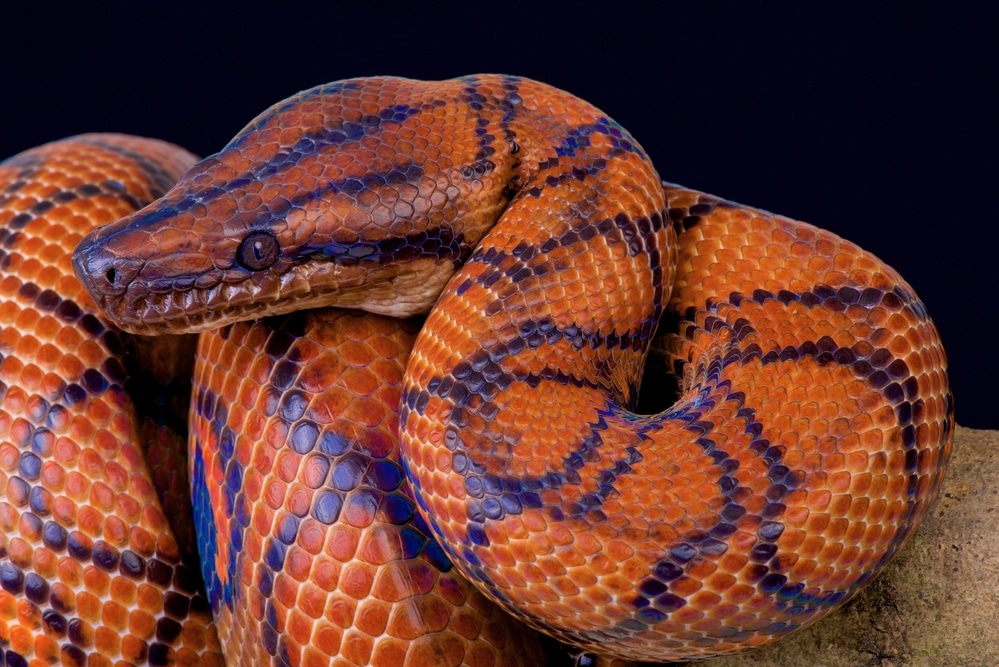
There are a selection of fully totally different species and subspecies of the rainbow boas (Epicrates cenchria sspp.), they often’re all pretty participating. Most have very fascinating and visually fascinating patterns, and your total group bears very shiny, iridescent scales. Nonetheless, the Brazilian subspecies (Epicrates cenchria cenchria) is on a completely fully totally different diploma, which makes it tower above its kin by means of fame.
Clad in a crimson or orange ground coloration with darkish blue to black markings alongside the once more and sides, these snakes are show-stoppers and on a regular basis draw a great deal of consideration at reptile expos and swap meets. Like most totally different rainbow boas, they attain a manageable measurement of about 6 toes (though some may develop barely larger), they often’ll survive on meals no larger than a large rat – no should feed these snakes rabbits or chickens as you can should do with an enormous frequent boa.
Rainbow boas are usually not pretty as tame as a lot of the calmest frequent, sand or rosy boas, nevertheless they’re usually easy to take care of. Over time, most captive-bred folks lastly be taught to easily settle for widespread, gentle coping with. They’re significantly troublesome to care for, as they require very extreme humidity ranges of their enclosures, which makes it tougher to keep up the enclosure clear.
We’d recommend true novices to look elsewhere, nevertheless keepers who’ve already saved a snake or two beforehand can seemingly succeed with this species. Assuming they’re ready to dedicate the right time and effort to caring for a barely troublesome species.
Conclusion
As you can see, there’s positively no shortage of boa species accessible to hobbyists. And whereas the seven species talked about above are undoubtedly a lot of the principally saved species, many others can be found. Viper boas (Candoia aspera), Cuban boas (Chilabothrus angulifer), and Columbian rainbow boas (Epicrates maurus) generally flip up at pet expos and retail retailers. For that matter and though we’ve excluded them proper right here, yellow (Eunectes notaeus) and inexperienced anacondas (Eunectes murinus) are arguably boas, as they match correct into the subfamily Boinae. Every species are pretty typically saved and out there.
Merely just remember to evaluation the needs of any boa species you intend to keep up, so it’s potential so that you can to supply your new pet the best high quality of life attainable. That’s useful for you, the animal after which complete snake-keeping pastime as a complete.











Leave a Reply